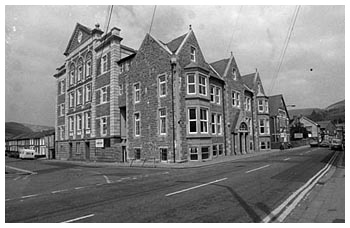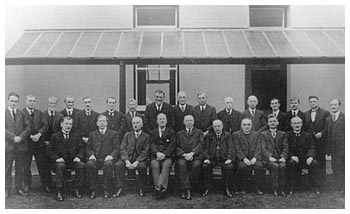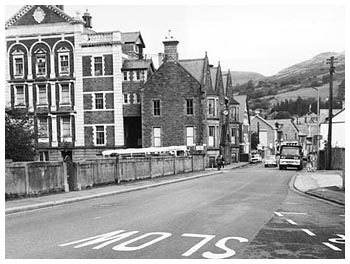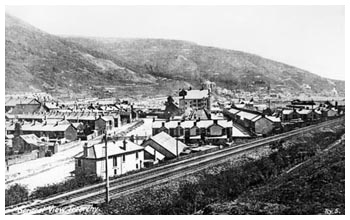
Treorchy |
|
The village of Treorchy apparently takes its name from the stream that flows from the mountainside above the village into the River Rhondda; on the 1875 Ordnance Survey map of this area the stream is referred to as ‘ Nant Orky', and Treorchy itself is spelt Treorky. The word Gorchi possibly comes from the welsh word Gorchwy, suggesting a stream marking a boundary. Prior to industrialisation the Tithe maps of the area show an unpopulated area of scattered farmhouses, such as Abergorchwy, Tile-du, and Glyn Coli. The area was predominantly meadows, pastures and woodland and farmed by tenant farmers such as Walter Edwards, Llewellyn Lewis and Mary Evans. Much of the land, in common with most of the Rhondda at that time, was owned by one of the great families of Glamorgan with much of Treorchy coming under the domain of the Marquis of Bute Estate. |
|
A General view of Lower Treorchy |
However in the 1850's the nature of the area began to change with the beginning of the exploitation of the Upper Rhondda's coal seams. This process was begun in 1855 with the opening of the Tylacoch Colliery followed in 1859 and 1860 by the Abergorchy and Glynoli Levels and the Abergorchy Colliery in 1865. Additionally the opening of the Parc and The Dare collieries in the nearby village of Cwmparc led to expansion of Treorchy with thousands of immigrants flooding into the area in search of work. |
| Hundreds of new houses were built to cater for this influx, as well as chapels to cater for their religious needs, and public houses and shops soon sprang up. By the 1900's Treorchy was a major shopping and social centre within the Rhondda. Treorchy from its earliest days was renowned as a cultural centre, and even today is home to the world famous Treorchy Male Choir as well as the Parc and Dare Theatre which hosts numerous local amateur plays, musicals, operas etc. as well as professional ones from all over the world. In 1928 Treorchy was also the venue chosen for the most prestigious event in the welsh cultural calendar, that of the Welsh National Eisteddfod, the only time it has ever been held in the Rhondda. |
|
With the decline of mining in the twentieth century Treorchy was better placed than many of the other villages in the Rhondda. Unlike many of the other villages Treorchy hosted a number of other industries, most notably the factories of companies such as Polikoff's , a clothing manufacturer, as well as a factory of the corporate giant EMI, and T.C.Jones part of the 600 group a steel construction factory. As such the desolation some villages underwent with the cessation of large scale mining operations, and the hardships and unemployment this entailed, were in some measure avoided in Treorchy. |
Upper Treorchy |
Parc and the Dare Workingmen's Hall and Theatre |
|
| Built originally as a Workingmen's Library and Institute, this imposing building was first opened in March 1895 at a cost of £4,000. It was financed by the worker's of the local collieries, the Parc and the Dare, through the first Mineworkers Trade Association. Miner's pledged a penny out of every pound they earned to finance its building and upkeep, a great commitment when you realise average wages were less than two pounds per week. | |
 |
In 1913 the original station street site was enlarged with the addition of the Parc and Dare Theatre to the structure, designed by Merthyr born architect Jacob Rees The original plan for the theatre was as a major music hall venue. However by the time of its completion it was obvious to its management committee that music hall had had its heyday and that the future lay with the new ‘moving pictures'. Thus the Parc and Dare Theatre began its life as a cinema, with the addition of live performances from local dramatic companies As well as hosting prestigious annual semi- national Eisteddfod. Playing a pivotal role in the cultural life of the local community. |
| The 1926 general strike had a severe effect on the Parc and Dare. Miners no longer had an income with which to support the hall, and having enough food on the table became a much greater priority than culture and entertainment. As such the hall faced bankruptcy and the miners were forced to sell 99% of their shares to the Ocean Coal Company. In 1930 the Parc and dare screened the first ‘talkie' picture, Broadway Melody, and crowds flocked from miles around to witness this new phenomenon. |
 |
 |
Post nationalisation the Parc and Dare Lodge of the National Union of Mineworkers re-purchased the hall at a cost of £35,000. With the advent of television and the decline of the local mining industry the Parc and Dare underwent a period of decline, making its closure almost inevitable. However the management of the hall donated it to the local authority, the Rhondda Borough Council, in 1975. Since that time the local authority has spent large amounts of money making the Parc and Dare a thriving cinema, theatre and concert hall and a valuable part of the Valley's cultural landscape. |

